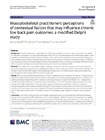| dc.contributor.author | Sherriff, Bronwyn | |
| dc.contributor.author | Clark, Carol | |
| dc.contributor.author | Killingback, Clare | |
| dc.contributor.author | Newell, Dave | |
| dc.date.accessioned | 2024-01-22T11:44:12Z | |
| dc.date.available | 2024-01-22T11:44:12Z | |
| dc.date.issued | 2023-04-05 | |
| dc.identifier.citation | Sherriff, B., Clark, C., Killingback, C., & Newell, D. (2023). Musculoskeletal practitioners’ perceptions of contextual factors that may influence chronic low back pain outcomes: a modified Delphi study. Chiropractic & Manual Therapies, 31(1), 1-28. https://doi.org/10.1186/s12998-023-00482-4 | en |
| dc.identifier.issn | 2045-709X | |
| dc.identifier.uri | https://aecc.archive.knowledgearc.net/handle/123456789/244 | |
| dc.description | Available under License - Creative Commons Attribution: https://creativecommons.org/licenses/by/4.0/ | en |
| dc.description.abstract | Background: Optimal shaping of contextual factors (CFs) during clinical encounters may be associated with analgesic responses in treatments for musculoskeletal pain. These CFs (i.e., the patient-practitioner relationship, patient’s and practitioner’s beliefs/characteristics, treatment characteristics, and environment) have not been widely evaluated by musculoskeletal practitioners. Understanding their views has the potential to improve treatment quality and effectiveness. Drawing on a panel of United Kingdom practitioners’ expertise, this study aimed to investigate their perceptions of CFs during the management of patients presenting with chronic low back pain (LBP).
Methods: A modified two-round online Delphi-consensus survey was conducted to measure the extent of panel agreement regarding the perceived acceptability and influence of five main types of CFs during clinical management of patients with chronic LBP. Qualified musculoskeletal practitioners in the United Kingdom providing regular treatment for patients with chronic LBP were invited to take part.
Results: The successive Delphi rounds included 39 and 23 panellists with an average of 19.9 and 21.3 years of clinical experience respectively. The panel demonstrated a high degree of consensus regarding approaches to enhance the patient-practitioner relationship (18/19 statements); leverage their own characteristics/beliefs (10/11 statements); modify the patient’s beliefs and consider patient’s characteristics (21/25 statements) to influence patient outcomes during chronic LBP rehabilitation. There was a lower degree of consensus regarding the influence and use of approaches related to the treatment characteristics (6/12 statements) and treatment environment (3/7 statements), and these CFs were viewed as the least important. The patient-practitioner relationship was rated as the most important CF, although the panel were not entirely confident in managing a range of patients’ cognitive and emotional needs.
Conclusion: This Delphi study provides initial insights regarding a panel of musculoskeletal practitioners’ attitudes towards CFs during chronic LBP rehabilitation in the United Kingdom. All five CF domains were perceived as capable of influencing patient outcomes, with the patient-practitioner relationship being perceived as the most important CF during routine clinical practice. Musculoskeletal practitioners may require further training to enhance their proficiency and confidence in applying essential psychosocial skills to address the complex needs of patients with chronic LBP. | en |
| dc.language.iso | en | en |
| dc.publisher | Chiropractic & Manual Therapies | en |
| dc.subject | Chronic low back pain | en |
| dc.subject | Musculoskeletal pain | en |
| dc.subject | Contextual factors | en |
| dc.subject | Delphi study | en |
| dc.subject | Placebo effect | en |
| dc.subject | Physician-patient relations | en |
| dc.subject | Health professional-patient relations | en |
| dc.subject | Physiotherapy | en |
| dc.subject | Chiropractic | en |
| dc.subject | Osteopathy | en |
| dc.title | Musculoskeletal practitioners’ perceptions of contextual factors that may influence chronic low back pain outcomes: a modified Delphi study | en |
| dc.type | Article | en |
| dc.identifier.doi | https://doi.org/10.1186/s12998-023-00482-4 | |
